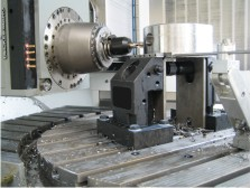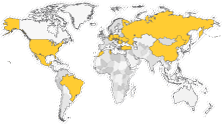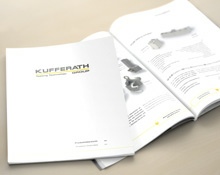






































Milling (a machining method) involves the use of a special milling tool to shape the material as desired by removing excess material in the form of chips. It is different to turning in that the metals, wood or plastics are processed by rotating the tool, while the workpiece is firmly clamped in place.
In conventional milling, also referred to as manual or mechanical milling, all three axes are operated manually via handwheels or simple mechanical feed units and the individual settings are read off scales attached to the cranks.
Modern CNC-controlled milling machines have largely replaced conventional milling, but they are still used in small workshops.
Milling (a machining method) involves the use of a special milling tool to shape the material as desired by removing excess material in the form of chips. It is different to turning in that the metals, wood or plastics are processed by rotating the tool, while the workpiece is firmly clamped in place.
In CNC milling, the milling machines (with up to five axes) are programmed by a machine control system. The individual axes can be controlled individually or together with feed rates, which also enables 3D milling. The production process can be fully automated in combination with an integrated tool changer and a tool magazine.
During the turning process (a machining method) a turning tool is used to manually shape the material as desired on a lathe by removing excess material in the form of chips. It is different to milling in that the metals, wood or plastics are processed by rotating the workpiece, while the tool is firmly clamped in place.
The tool, clamped firmly in a bracket, is moved precisely along the workpiece's longitudinal and transverse axis. Scale rings on the tool carriers ensure straight workpiece edges and dimensional accuracy.
In series production conventional lathes have largely been replaced by CNC lathes, however, conventional turning remains essential for some parts of industry, in craft as well as in learning workshops in vocational colleges and universities.
During the turning process (a machining method) a turning tool is used to manually shape the material as desired on a lathe by removing excess material in the form of chips. It is different to milling in that the metals, wood or plastics are processed by rotating the workpiece, while the tool is firmly clamped in place.
In CNC turning, a machine control unit adjusts the movements and also performs all ancillary tasks such as speed selection and control. Automatic CNC lathes are able to operate much more quickly and with considerably greater precision than lathes on conventional machines. The tool replacement and material feed is usually performed automatically for CNC lathes and contours can be created along the longitudinal or transverse axis without any problems.
Wire-cut EDM is a shaping production process or an electrothermic separation process (cutting process) for conductive materials. It is also referred to as wirecutting; wire eroding, spark erosion cutting or wire-cut eroding.
Wire-cut EDM is a cutting process that creates very narrow cutting widths for even very thick materials. The material to be cut is removed using discharges (sparks) between an electrode (the erosion wire) and the workpiece.
The electrical energy is converted into heat through a spark-over causing the electrodes to melt and remove the material. In contrast to cutting production processes (turning, milling, grinding, etc.) the material is not removed mechanically. The precision of the process is based on the fact that the spark always jumps across at the point where the distance between the workpiece and the wire is at a minimum.
Wire-cut EDM machines generally have five axes. Brass is generally used as the material for the cutting wire, but copper, tungsten or steel are also possible. Eroding wires are often coated in zinc and other materials to increase the cutting performance and precision even further.


 • Profile engineering
• Injection moulding (plastics processing)
• PCB production
• Surface treatment
• Wire-cut EDM
• CNC turning/milling
• Profile engineering
• Injection moulding (plastics processing)
• PCB production
• Surface treatment
• Wire-cut EDM
• CNC turning/milling









 • Asia
• America
• Africa
• Europe
» Contact
• Assembly
• Production
• Programming
• Engineering
• Test Engineering
» Products
• Quality Management
• Company History
• Management's Salute
» Company
• Asia
• America
• Africa
• Europe
» Contact
• Assembly
• Production
• Programming
• Engineering
• Test Engineering
» Products
• Quality Management
• Company History
• Management's Salute
» Company














 Sales Request
Service Request
Sales Request
Service Request

 • Russia
• China
» Asia (with Russia)
• Brazil
• Nicaragua
• Mexico
• USA
» America
• Tunisia
• Morocco
» Africa
• Ukraine
• Turkey
• Czech Republic
• Slovakia
• Romania
• Portugal
• Poland
• Bulgaria
• Germany (Headquarter Moers)
» Europe
» Contact Details Germany
• Russia
• China
» Asia (with Russia)
• Brazil
• Nicaragua
• Mexico
• USA
» America
• Tunisia
• Morocco
» Africa
• Ukraine
• Turkey
• Czech Republic
• Slovakia
• Romania
• Portugal
• Poland
• Bulgaria
• Germany (Headquarter Moers)
» Europe
» Contact Details Germany





 • Online Flip Catalogue
» Downloads
• Mission Statement
» Corporate Philosophy
• ISO 9001-certification
» Quality Management
• Two decades quality
» Company History
• Greetings from the Management
» Headquarter Moers
» Company
• Online Flip Catalogue
» Downloads
• Mission Statement
» Corporate Philosophy
• ISO 9001-certification
» Quality Management
• Two decades quality
» Company History
• Greetings from the Management
» Headquarter Moers
» Company






























